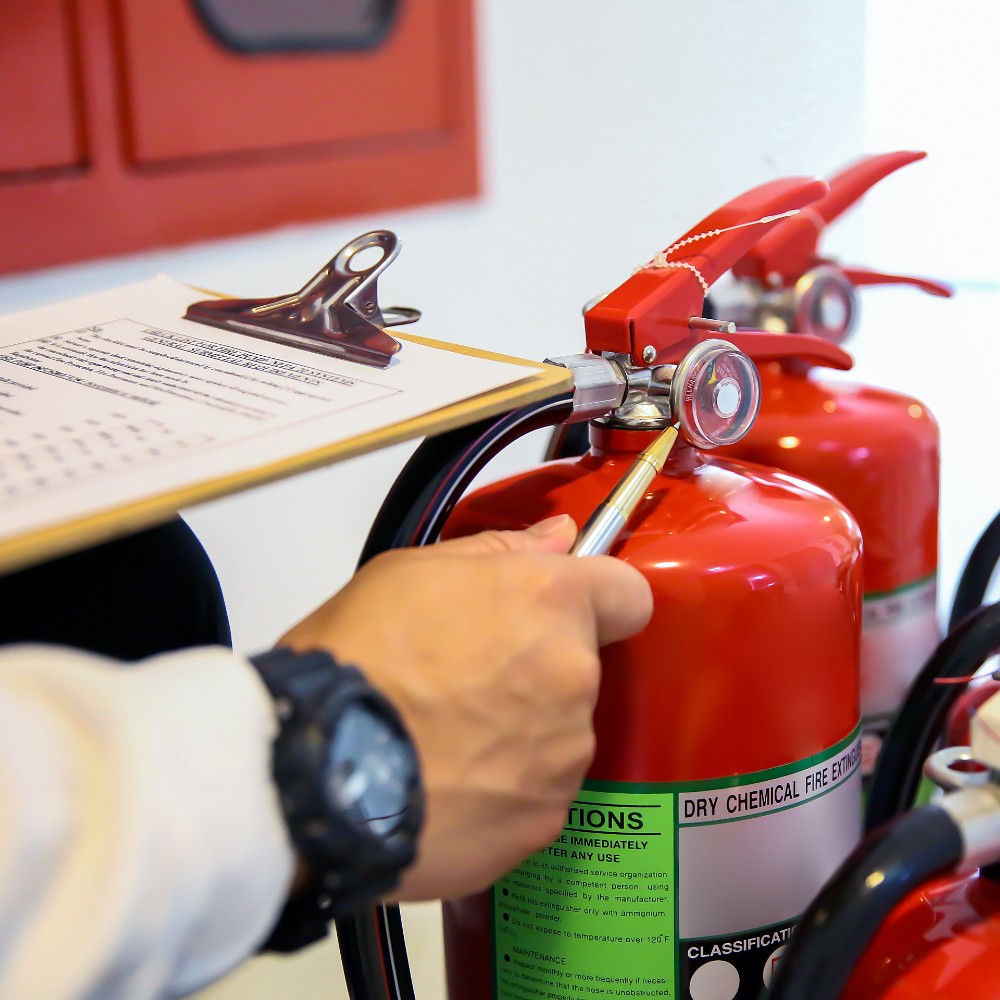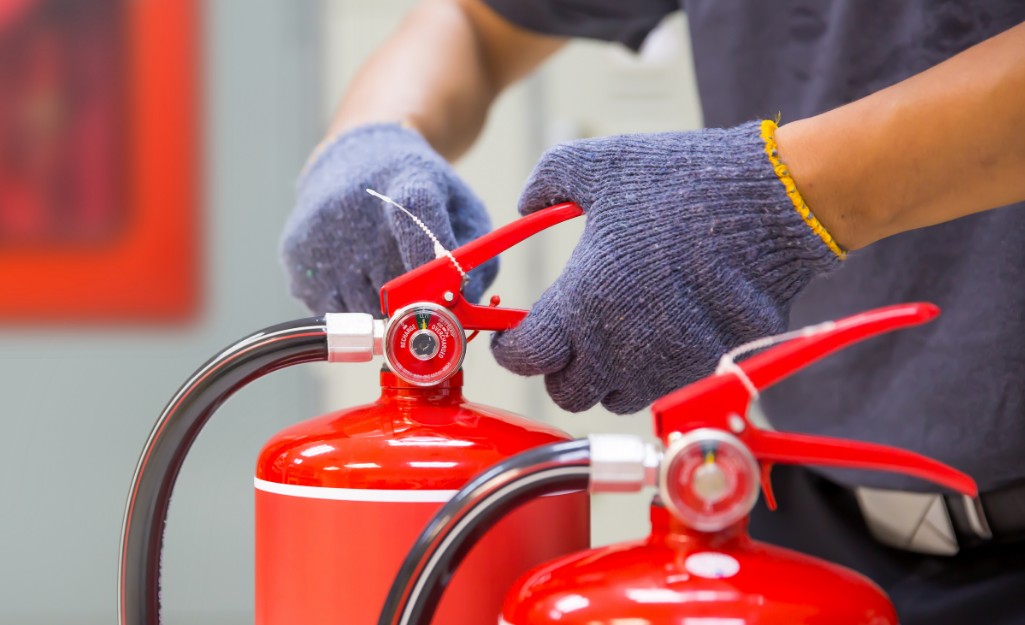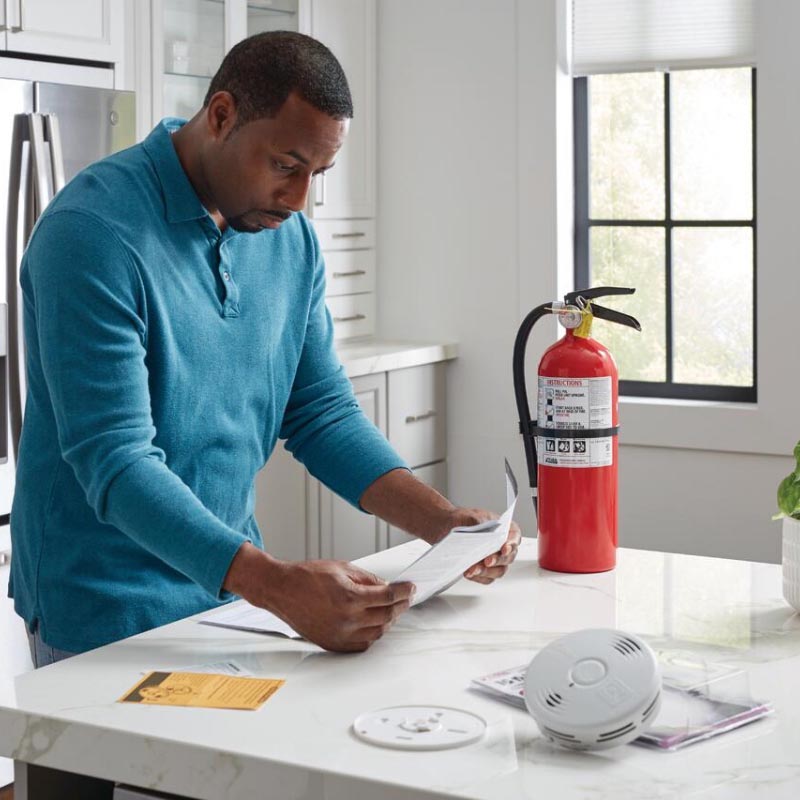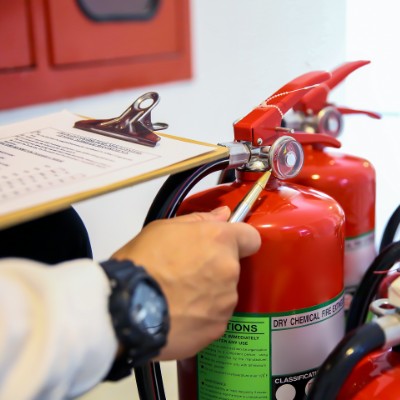How to Inspect Fire Extinguishers

Last updated August 12, 2024
Fire extinguishers need to be inspected monthly, maintained annually and tested every few years. While manufacturers have their own requirements, the National Fire Protection Agency (NFPA) maintains the general fire extinguisher inspection codes.
This guide covers how to properly inspect, maintain and test fire extinguishers.
Difficulty:
Beginner
Duration:
Under 2 hours
Table of Contents
How Often Do Fire Extinguishers Need to be Inspected?
Fire Extinguisher Maintenance
How to Test Fire Extinguishers
More Products. More Tools. More Perks.
How Often Do Fire Extinguishers Need to be Inspected?

NFPA 10 and OSHA require fire extinguisher inspections once a month beginning when a new unit is installed. Check fire extinguishers more frequently if they are installed in locations that are more prone to damage, tampering, rust or harsh temperatures.
Fire extinguisher inspections can ensure a fire extinguisher will be reliable and effective during an emergency. There are no certification requirements for conducting an inspection, but it is important to familiarize yourself with NFPA 10 fire extinguisher codes and guidelines. Check with your local government or authority having jurisdiction for any rules or codes specific to your area.
To inspect a fire extinguisher, follow these steps:
- Ensure the fire extinguisher is in its proper place. If you find it outside of where it should normally stay, return it to the designated area.
- Verify the fire extinguisher is in a visible place, or that signage indicates its location.
- Verify the fire extinguisher is easily accessible.
- Check the pressure gauge to make sure it reads in the green range.
- Make sure the fire extinguisher is full. This can be verified by lifting the unit or weighing it.
- Check for any wear or damage on the fire extinguisher, such as on the hose, nozzle, discharge handle or pressure gauge. For wheeled fire extinguishers, check the tires, wheels and carriage as well.
- For non-rechargeable fire extinguishers, depress the green button on the push-to-test pressure indicator. If the unit is sufficiently pressurized, the button will pop back up immediately.
Maintain a record of each inspection as far back as 12 months. This is typically accomplished with an inspection tag or label to be attached to the fire extinguisher. Alternatively, you can keep a record on paper or digital files. Inspections records need to include the following information:
- The month and year of the inspection
- The person conducting the inspection
Some local fire stations offer fire extinguisher inspections alongside other safety services. However, each fire department is different and some may not offer this service due to liability concerns. Check with your local fire department to see what fire safety services they offer.
Pro Tip: Record your most recent inspection records on the tag or label, and copy them into a document containing all prior inspections for future reference.
Fire Extinguisher Maintenance

Fire extinguisher maintenance procedures typically vary between manufacturers and models and are included in the service manual. Most general maintenance requires examining, cleaning and replacing dirty or damaged parts, including the following steps:
- Clean the fire extinguisher of any dirt or foreign material and check that the instruction label is fully attached and legible. Check the casing for any damage like dents or cracks. If any damage is found and raises doubt about the casing's integrity, hydrostatic testing is necessary.
- Examine the fire extinguisher for any missing or substituted parts. Not all manufacturers approve non-factory replacement parts.
- Remove and check the locking pin for ease of use. If it is bent or removal is difficult, replace the locking pin.
- If the pressure gauge is damaged or is an improper replacement, depressurize the fire extinguisher and replace the pressure gauge. If the pressure is reading very low or very high, check for leaks. If the extinguisher is over pressurized, depressurize the extinguisher and follow the service manual instructions for recharging.
- Check the discharge lever for any dirt or corrosion which might prevent movement. If the lever, handle or rivets are damaged, replace them.
- Check the weight of the fire extinguisher and compare it to the weight specified on the label. If there is any discrepancy, remove the nozzle and hose. Then follow service manual instructions for complete maintenance and recharge procedures.
- If a recharge is unnecessary, continue maintenance with hose and nozzle examination. Blow air through the hose and nozzle to make sure there is clear passage. Replace any damaged parts.
- Examine the valve for any corrosion or damage in the hose thread connection. If a valve removal is necessary, follow the complete maintenance procedures. If not, reinstall the nozzle or hose.
- Attach a new tamper seal, and record your service information on the inspection tag.
- Return the fire extinguisher to its designated area. Ensure it fits any bracket or casing properly.
NFPA 10 states that fire extinguisher maintenance must be conducted by a certified person. However, the NFPA does not issue certifications. Instead, you can obtain a certification by taking a test designated by your fire department, city hall or other authority-having jurisdiction (AHJ). While the content of these tests may vary by area, the majority of the relevant information will come from NFPA 10.
External maintenance is required once a year, as well as whenever hydrostatic testing is necessary. Internal maintenance is conducted every 1-6 years, depending on the manufacturer and model of fire extinguisher. One example of this is the 6-year requirement for stored pressure, dry chemical fire extinguishers.
When conducting an internal examination, follow the manufacturer’s guidelines for depressurizing, opening and emptying the casing. Once the fire extinguisher is safely opened, remove the extinguishing agent and valve assembly. Inspect the valve assembly for any damage or wear and the inside of the casing for any damage or corrosion. Reattach the valve assembly to create a seal. Replace the extinguishing agent with new material, and then follow the service manual’s guidelines for reassembly.
Maintenance recordkeeping follows similar guidelines to inspections. The inspection tag can include maintenance, which requires the following information:
- Month and year the maintenance was conducted
- Person conducting the maintenance
- Name of the maintenance worker’s agency or employer
If an internal examination was conducted, extinguishers need a verification-of-service collar around the neck of the casing. This must include the month and year the maintenance was conducted and the name of the worker’s agency or employer.
How to Test Fire Extinguishers

NFPA 10 requires hydrostatic testing every 5-12 years depending on the type of fire extinguisher. Testing the locking pin is the only form of testing you should attempt if you are not certified.
To test a fire extinguisher's locking pin and ensure the unit is pressurized, place your thumb over the pin and press it down gently. When you move your thumb, the pin should pop back up immediately. The fire extinguisher is likely losing pressure if the pin does not come back up or rises slowly.
Certified professionals are authorized to conduct hydrostatic testing on fire extinguishers to ensure there are no leaks. Hydrostatic tests must begin with internal and external examinations of the fire extinguisher. They must first empty the fire extinguisher of any leftover material or air pressure, then disassemble it save for the shell and the hose. Fill the shell and hose with enough water pressure to make any possible leaks visible.
If no leaks are found after a hydrostatic test, the fire extinguisher can be reassembled and recharged for continued use. However, if any leaks, dents or damage to valves or couplings are found, the fire extinguisher must be condemned.
Low-pressure fire extinguishers require a label to confirm hydrostatic testing. This label should include the following information:
- Name of person conducting the hydrostatic test
- The date of the test
- The pressure at which the test was conducted
High-pressure extinguishers require the identification number of the tester and the date of the test stamped onto the unit. Place this stamp on the top, head, neck or foot ring of the extinguisher.
More Products. More Tools. More Perks.

Be more competitive and boost your bottom line with Pro Xtra, The Home Depot’s free loyalty program built for Pros. Sign up today to access the enhanced Pro Online Experience, built with the online business tools and time-saving features Pros need.
Save money on large orders with the Volume Pricing Program and your free Pro Xtra account. Just assemble your project list, bring it to the Pro Desk at The Home Depot and let our Pro associates get you the lowest price possible.



























